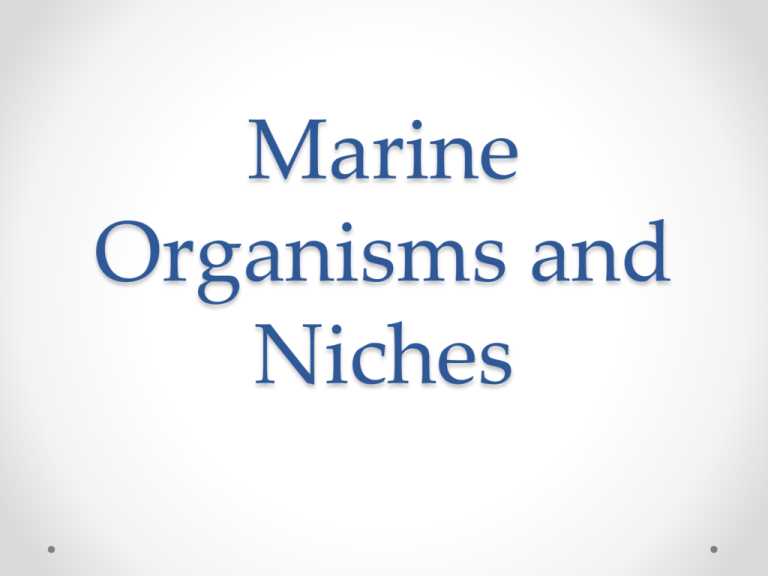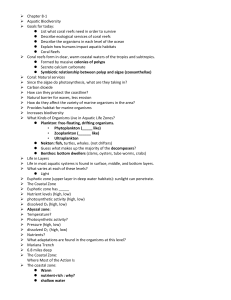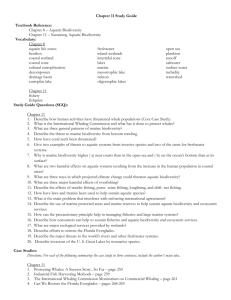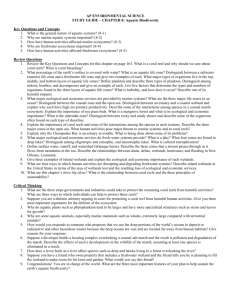Freshwater and Marine Organisms and Niches
advertisement

Marine Organisms and Niches Estuaries Definition • A partially enclosed area of coastal water where sea water mixes with freshwater. Salt Marshes • The ground here is saturated with water and there is little oxygen, so decay takes place slowly. It has a surface inlet and outlet, and contains many invertebrates. It is also the breeding ground for many ocean animals. Ex. crabs and shellfish. Mangrove Forests • These are along warm, tropical coasts where there is too much silt for coral reefs to grow. It is dominated by salt-tolerant trees called mangroves (55 different species exist). It also helps to protect the coastline from erosion and provides a breeding nursery for some 2000 species of fish, invertebrates, and plants. Importance of Estuaries • Just one acre of estuary provides $75,000 worth of free waste treatment, and has a value of about $83,000 when recreation and fish for food are included. • Prime Kansas farmland has a top value of $1,200 and an annual production value of $600. The Everglades Southern Florida to the Keys Case Study: Restoring the Florida Everglades • The world’s largest ecological restoration project involves trying to undo some of the damage inflicted on the Everglades by human activities. o 90% of park’s wading birds have vanished. o Other vertebrate populations down 75-95%. o Large volumes of water that once flowed through the park have been diverted for crops and cities. o Runoff has caused noxious algal blooms. Problems • As Miami develops, it encroaches on everglades. Plus, it prompts people vs. wildlife. It is freshwater and local areas are draining it. Restoring the Florida Everglades • The project has been attempting to restore the Everglades and Florida water supplies. Figure 12-10 Restoration • Build huge aqueduct, or find other sources of fresh water an protect it federally under endangered species act, etc. SALTWATER LIFE ZONES • The oceans that occupy most of the earth’s surface provide many ecological and economic services. Figure 6-4 Marine Ecosystems • Scientists estimate that marine systems provide $21 trillion in goods and services per year – 70% more than terrestrial ecosystems. Figure 6-4 Marine Biomes Aquatic systems contain floating, drifting, swimming, bottom-dwelling, and decomposer organisms. o Plankton: important group of weakly swimming, free-floating biota. • Phytoplankton (plant)- Producers that support most aquatic food chains o Algae, cyanobacteria • , Zooplankton (animal)- herbivores that feed on phytoplankton or other zooplankton o Krill, small crustaceans o Necton: fish, turtles, whales • top consumers in the aquatic ecosystem o Benthos: bottom dwellers (barnacles, oysters). • primary consumers, decomposers Phytoplankton • Description – small drifting plants • Niche – they are producers that support most aquatic food chains • Example – cyanobacteria & many types of algae Zooplankton • Description – herbivores that feed on phytoplankton or other zooplankton • Niche – food stock for larger consumers • Example – krill; small crustaceans Nekton • Description – larger, strongswimming consumers • Niche – top consumers in the aquatic ecosystem • Example – fish, turtles, and whales Benthos • Description – bottom-dwelling creatures • Niche – primary consumers, decomposers • Example – barnacles, oysters, and lobsters The Coastal Zone: Where Most of the Action Is • The coastal zone: the warm, nutrient-rich, shallow water that extends from the high-tide mark on land to the gently sloping, shallow edge of the continental shelf. • The coastal zone makes up less than 10% of the world’s ocean area but contains 90% of all marine species. o Provides numerous ecological and economic services. o Subject to human disturbance. Biological Zones in the Open Sea: Light Rules • Euphotic zone: brightly lit surface layer. o Nutrient levels low, dissolved O2 high, photosynthetic activity. • Bathyal zone: dimly lit middle layer. o No photosynthetic activity, zooplankton and fish live there and migrate to euphotic zone to feed at night. • Abyssal zone: dark bottom layer. o Very cold, little dissolved O2. Rocky and Sandy Shores: Living with the Tides • Organisms in intertidal zone develop specialized niches to deal with daily changes in: o Temperature o Salinity o Wave action Figure 6-9 Threats to Coral Reefs: Increasing Stresses • Biologically diverse and productive coral reefs are being stressed by human activities. Figure 6-11 Core Case Study: Why Should We Care About Coral Reefs? • Coral reefs form in clear, warm coastal waters of the tropics and subtropics. o Formed by massive colonies of polyps. Figure 6-1 Core Case Study: Why Should We Care About Coral Reefs? • Help moderate atmospheric temperature by removing CO2 from the atmosphere. • Act as natural barriers that help protect 14% of the world’s coastlines from erosion by battering waves and storms. • Provide habitats for a variety of marine organisms. We Have Much to Learn about Aquatic Biodiversity • Greatest marine biodiversity o Coral reefs o Estuaries o Deep-ocean floor • Biodiversity is higher o Near the coast than in the open sea o In the bottom region of the ocean than the surface region Human Activities Are Destroying and Degrading Aquatic Habitats • Habitat loss and degradation o Marine • Coastal • Ocean floor: effect of trawlers o Freshwater • Dams • Excessive water withdrawal Invasive Species Are Degrading Aquatic Biodiversity • Invasive species o Threaten native species o Disrupt and degrade whole ecosystems • Three examples o Water hyacinth: Lake Victoria (East Africa) o Asian swamp eel: waterways of south Florida o Purple loosestrife: indigenous to Europe • Treating with natural predators—a weevil species and a leaf-eating beetle—Will it work? Science Focus: How Carp Have Muddied Some Waters • Lake Wingra, Wisconsin (U.S.): eutrophic o Contains invasive species • Purple loosestrife and the common carp • Dr. Richard Lathrop o Removed carp from an area of the lake • This area appeared to recover Population Growth and Pollution Can Reduce Aquatic Biodiversity • Nitrates and phosphates mainly from fertilizers enter water o Leads to eutrophication • Toxic pollutants from industrial and urban areas







